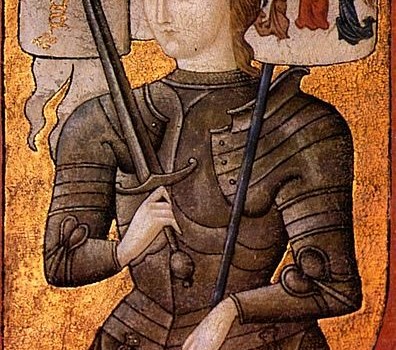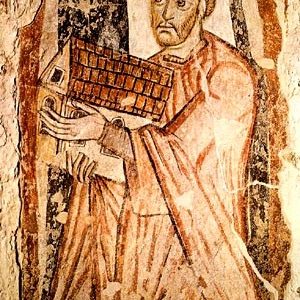
 On January 6, 1412, Joan of Arc (or Jeanne d’Arc, as she is known in France) was born to pious parents of the French peasant class, at the obscure village of Domrémy, near the province of Lorraine. Joan seems to have been the youngest of a family of five. She never learned to read or write, but was skilled in sewing and spinning. At the age of 13, she experienced her first supernatural visions: it was at first simply a voice, as if someone had spoken quite close to her, but the voice was accompanied by a blaze of light. Later on she clearly came to discern those who spoke to her as St. Michael, St. Margaret, St. Catherine, and others.
On January 6, 1412, Joan of Arc (or Jeanne d’Arc, as she is known in France) was born to pious parents of the French peasant class, at the obscure village of Domrémy, near the province of Lorraine. Joan seems to have been the youngest of a family of five. She never learned to read or write, but was skilled in sewing and spinning. At the age of 13, she experienced her first supernatural visions: it was at first simply a voice, as if someone had spoken quite close to her, but the voice was accompanied by a blaze of light. Later on she clearly came to discern those who spoke to her as St. Michael, St. Margaret, St. Catherine, and others.
At first the messages were personal and general. But in May 1428, the voices told Joan to go to the King of France and help him reconquer his kingdom. She was originally laughed at by Robert de Baudricourt, the French commander at Vaucouleurs, but his skepticism was overcome when Joan’s prophecies came true and the French were defeated in the Battle of Herrings outside Orléans in February 1429.
After an examination by theologians at Poitiers cleared her of all suspicion of heresy, the 17-year-old girl was given a small army with which she lead an expedition to relieve besieged Orléans on May 8, 1429. She then enjoyed a series of spectacular military successes, during which the king was able to enter Rheims and be crowned with her at his side.
In May 1430, as she was attempting to relieve Compiègne, she was captured by the Burgundians and sold to the English while Charles and the French did nothing to save her. After months of imprisonment, she was tried at Rouen by a tribunal presided over by the infamous Peter Cauchon, Bishop of Beauvais, who hoped that the English would help him to become archbishop.
Charged with heresy and witchcraft, her visions were declared to be of diabolical origin. Joan was trapped into making some damaging statements and was later tricked into signing a form of recantation on May 23, 1431. But when she again dressed in male attire, which she had agreed to abandon, she was condemned as a lapsed heretic and burned at the stake at Rouen on May 30, 1431, the victim of her enemies’ determination to destroy her. She was nineteen years old.
A court appointed by Pope Callistus III found her innocent in 1456, and she was canonized in 1920. She is considered one of the patrons of France, as well as the patron of soldiers.
Lessons
1. While it’s unlikely that any of us will be called upon by God to perform such extraordinary deeds as Joan, why do we find it so hard to deal with ordinary peer pressure? Joan was no doubt fully aware how ridiculous it would seem for a young girl to come forward and claim that God had given her the power to free France — but she did as God commanded anyway, and people eventually came to see that God was indeed with her. Let us pray to Joan for the courage to do God’s will, no matter how unpopular or ridiculous we may seem in the eyes of others.
2. While historians puzzle over the fact that Joan returned to her male dress after agreeing to abandon it, one likely theory is that she did it to protect her honor against the rude attentions of the English guards, whom she had complained about bitterly. If this is so, then it becomes clear that Joan, knowing that male attire would lead to her being condemned once again as a heretic, chose modesty over the preservation of her own life — something to think about in a time when modesty seems to be an all-but-forgotten virtue.
Other Saints We Remember Today
Most Sacred Heart of Jesus
St. Felix I (274), Pope, Martyr
St. Ferdinand III (1252), King of Castile & Leon










